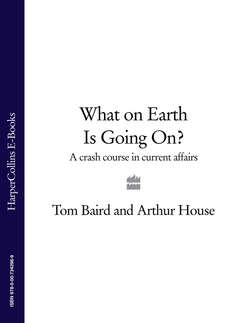Читать книгу What on Earth is Going On?: A Crash Course in Current Affairs - Arthur House - Страница 16
ОглавлениеColombia
When was the country formed?
The area now known as Colombia was colonised by the Spanish in the 16th century, along with much of South and Central America. In the 18th century, Bogotá (capital of present-day Colombia) became, with Mexico City and Lima, one of the main administrative centres of the Spanish colonies in America. Napoleon’s conquest of Spain in 1810 caused several of its
South American colonies to break away and declare their independence, which was properly achieved for Colombia by 1819 after an independence struggle spearheaded by Simón Bolívar (’the Liberator’) and Francisco de Paula Santander. The resulting state was called Gran Colombia and included Colombia, Panama, Ecuador and Venezuela. The latter two countries broke away in 1830, however, and the country went through various changes of name before the Republic of Colombia was founded in 1886. Panama declared its independence in 1903.
Conservatives vs Liberals
In 1849 Colombia’s Conservative and Liberal parties were founded, with contrasting political visions based on those of the country’s two founders, Bolívar and Santander. Over the next century, competition between these parties often spilled over into political violence when extremist factions sought to eliminate their rivals by any means possible. Sometimes this violence led to wider civil unrest, most notably the ‘Thousand Days War’ (1899-1902), which resulted in over 100,000 deaths, and ‘La Violencia’ (1948-57), which caused more than 250,000. To end ‘La Violencia’, Conservatives and Liberals agreed to form a National Front from 1958-74; this was a power-sharing arrangement in which each party took turns to rule for four years at a time.
Rebels with a cause
In the 1960s, however, left-wing guerrilla groups started appearing; the two most prominent of these were, and still are, the Revolutionary Armed Forces of Colombia (FARC), and National Revolution Army (ELN), both established in 1964. These two rival groups were founded upon Marxist principles, are based in the mountains of southern and eastern Colombia and claim to fight for the poor and against the disparity of wealth in the country. Various right-wing paramilitary groups also sprang up to protect local interests and fight the guerrillas, combining forces in 1997 to create the United Self-Defence Forces of Colombia (AUC). All of the above groups are listed as terrorist organisations by the US and EU and fund their operations largely via their links to the cocaine trade. Between them they have been responsible for thousands of kidnappings over the last few decades, as well as assassinations, hijacks, massacres of civilians, rapes and the use of child soldiers. For decades the guerrillas and the paramilitaries have fought against each other and the government in a sporadic and bloody ongoing conflict.
Coca-Colombia
Although Colombia is the world’s largest producer of emeralds, it is most famous—or infamous—for its cocaine production. There was relatively little cocaine trafficking from Colombia in the 1960s, but in the following decade a growing demand for the new drug of choice in the US and Europe saw production boom. Soon Colombian drug cartels and kingpins became extremely rich off the back of this illegal trade; the drug baron Pablo Escobar even made it on to the Forbes Rich List before he was killed in 1993. Since 2000, the US has spent $6 billion on ‘Plan Colombia’, a programme to combat the drugs trade, which includes providing the Colombian army with training and equipment. The initial targets of the plan were not met, and Colombia still supplies the US with 90% of its cocaine. There are signs, however, that anti-narcotic operations may be beginning to work: 2008 saw Colombian coca cultivation fall by 18% and cocaine production fall by 28%.
El Presidente
President Álvaro Uribe has won praise both at home and abroad for his aggressive stance against the rebels. He was elected president in 2002 and won a second term four years later. He has been consistently popular, with approval ratings of at least 65%—a figure that would be the envy of most other politicians worldwide. He is in favour of free trade and privatisation (see Free Trade), while his economic policies and efforts to deal with guerrilla groups and paramilitaries have given the economy a boost.
Kidnappings have gone down in number during his presidency; in 2000 there were 3,572 kidnappings, but by 2006 this had been reduced to 521. In July 2007 the dramatic rescue of former Colombian presidential candidate Ingrid Betancourt, along with 14 other hostages, caught the world’s attention and dealt a blow to their captors, FARC. With the paramilitaries he has also had some success, including demobilising 31,000 soldiers, although this was on the condition (heavily criticised by some) that they received comparably soft sentences and were exempt from extradition.
Despite these developments, Uribe’s reign has not been free from scandal. In 2006 some lawmakers within his government were discovered to have links with the AUC. Although this ‘parapolitics’ scandal didn’t embroil the president himself, his cousin Mario Uribe was arrested. Also, despite the government’s efforts, cocaine production and export remains a huge problem, while the guerrilla groups and paramilitaries, if somewhat depleted, remain at large.
Gabriel García Márquez
Márquez is probably the best-known living Colombian. Born in 1928 in Aracataca, a town in the north of the country, he studied as a lawyer but soon switched to journalism. He was sent on a writing assignment to Europe in 1955, and while there one of the Colombian newspapers for which he was writing shut down, prompting him to stay in Paris. He has since lived mostly outside his homeland in a number of different countries, including Mexico, Spain and Venezuela. His novels include One Hundred Years of Solitude and Love in the Time of Cholera. Márquez was awarded the Nobel Prize for Literature in 1982.
